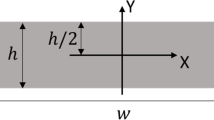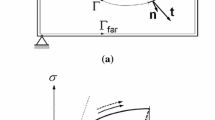Abstract
The concept of J-controlled crack growth is extended to J−A 2 controlled crack growth using J as the loading level and A 2 as the constraint parameter. It is shown that during crack extension, the parameter A 2 is an appropriate constraint parameter due to its independence of applied loads under fully plastic conditions or large-scale yielding. A wide range of constraint level is considered using five different types of specimen geometry and loading configuration; namely, compact tension (CT), three-point bend (TPB), single edge-notched tension (SENT), double edge-notched tension (DENT) and centre-cracked panel (CCP). The upper shelf initiation toughness J IC, tearing resistance T R and J−R curves tested by Joyce and Link (1995) for A533B steels using the first four specimens are analysed. Through finite element analysis at the applied load of J IC, the values of A 2 for all specimens are determined. The framework and construction of constraint-modified J−R curves using A 2 as the constraint parameter are developed and demonstrated. A procedure of transferring the J−R curves determined from standard ASTM procedure to non-standard specimens or practical cracked structures is outlined. Based on the test data, the constraint-modified J−R curves are presented for the test material of A533B steel. Comparison shows the experimental J−R curves can be reproduced or predicted accurately by the constraint-modified J−R curves for all specimens tested. Finally, the variation of J−R curves with the size of test specimens is produced. The results show that larger specimens tend to have lower crack growth resistance curves.
Similar content being viewed by others
References
Alexander, D.J. (1993). Fracture toughness measurements with sub-size Disk Compact specimens. Small Specimens Test Techniques Applied to Nuclear Reactor Vessel Thermal Annealing and Plant Life Extension, ASTM STP 1204, American Society of Testing and Materials, Philadelphia, 130–142.
ASTME 1820-99 (1999). Standard Test Method for J-Integral Characterization of Fracture Toughness, American Society for Testing and Materials, Philadelphia.
Betegon, C. and Hancock, J.W. (1991). Two parameter characterization of elastic-plastic crack-tip fields. Journal of Applied Mechanics 58, 104–110.
Brocks, W., Ebertle, A., Fricke, S. and Veith, H. (1994). Large stable crack growth in fracture mechanics specimens. Nuclear Engineering and Design 151, 387–400.
Chao, Y.J., Yang, S. and Sutton, M.A. (1994). On the fracture of solids characterized by one or two parameters: theory and practice. Journal of the Mechanics and Physics of Solids 42, 629–647.
Chao, Y.J. and Zhang, L. (1997). Tables of plane strain crack tip fields: HRR and higher order terms, Me-Report, 97-1, Department of Mechanical Engineering, University of South Carolina.
Chao, Y.J. and Zhu, X.K. (1998). J-A2 Characterization of Crack-Tip Fields: Extent of J-A2 Dominance and Size Requirements. International Journal of Fracture 89, 285–307.
Chao, Y.J., Zhu, X.K., Lam, P.S., Louthan, M.R. and Iyer, N.C. (2000). Application of the two-parameter J-A2 description to ductile crack growth. To appear in ASTM STP1389 (the 31st National Symposium on Fatigue and Fracture Mechanics), American Society for Testing and Materials, Philadelphia.
Eisele, U., Roos, E., Seidenfuss, M. and Silcher, H. (1992). Determination of J-integral-based crack resistance curve and initiation values for the assessment of cracked large-scale specimens. Fracture Mechanics: twentysecond symposium (Volume I), ASTM STP 1133, American Society for Testing and Materials, Philadelphia, 37–59.
Elliot, C., Emark, M., Lucas, G.E., et al. (1991). Development of disk compact tension specimens and test techniques for HFIR irradiation. Journal of Nuclear Materials 179, 434–437.
Gilbert, C.J., Cao, J.J., De Jonghe, L.C. and Ritchie, R.O. (1997). Crack-growth resistance-curve behaviour in silicon carbide: small versus long cracks. Journal of American Ceramics Society 80, 2253–2261.
Goldman, N.J. and Hutchinson, J.W. (1975). Fully plastic crack problems: the cracked -cracked strip under plane strain. International Journal of Solids and Structures 11, 575–591.
Gullerud, A.S. and Dodds, R.H. (1995). J-Q and toughness scaling model solutions for M(T), DE(T), SE(B), SE(T), and C(T) specimens. International Journal of Fracture 72, R11–R21.
Hancock, J.W., Reuter, W.G. and Parks, D.M. (1993). Constraint and toughness parameterised by T. Constraint effects in fracture, ASTM STP 1171, American society of Testing and Materials, Philadelphia, pp. 21–40.
Henry, B.S., Luxmoore, A.R. and Sumpter, J.D.G. (1996). Elastic-plastic fracture mechanics assessment of low constraint aluminium test specimens. International Journal of Fracture 81, 217–234.
Ilyushin, A.A. (1946). The theory of small elastic-plastic deformations. Prikadnaia Matematika i Mekhanika, P.M.M. 10, 347–356.
Joyce, J.A. and Link, R.E. (1995). Effects of constraint on upper shelf fracture toughness. Fracture Mechanics: 26th Volume, ASTM STP 1256, American Society for Testing and Materials, Philadelphia, 142–177.
Joyce, J.A. and Link, R.E. (1997). Application of two parameter elastic-plastic fracture mechanics to analysis of structures. Engineering Fracture Mechanics 57, 431–446.
Kikuchi, M. (1997). Study of the effect of the crack length on the JIC value. Nuclear Engineering and Design 174, 41–49.
Marschall, C.W., Papaspyropoulos, V. and Landow, M.P. (1989). Evaluation of attempts to predict large-crackgrowth J _R curves from small specimen tests. Nonlinear Fracture Mechanics: Volume II -Elastic Plastic Fracture, ASTM STP 995, American Society of Testing and Materials, Philadelphia, 123–143.
Moyer, E.T., McCoy, H. and Sarkani, S. (1997). Prediction of stable crack growth using continuum damage mechanics. International Journal of Fracture 86, 375–384.
Nikishkov, G.P., Bruckner-Foit, A. and Munz, D. (1995). Calculation of the second fracture parameter for finite cracked bodies using a three-term elastic-plastic asymptotic expansion. Engineering Fracture Mechanics 52, 685–701.
O'Dowd, N.P. (1995). Applications of two parameter approaches in elastic-plastic fracturemechanics. Engineering Fracture Mechanics 52, 445–465.
O'Dowd, N.P. and Shih, C.F. (1991). Family of crack-tip fields characterized by a triaxiality parameter -I. Structure of fields. Journal of the Mechanics and Physics of Solids 39, 989–1015.
O'Dowd, N.P. and Shih, C.F. (1992). Family of crack-tip fields characterized by a triaxiality parameter -II. Fracture applications. Journal of the Mechanics and Physics of Solids 40, 939–963.
O'Dowd, N.P. and Shih, C.F. (1994). Two-parameter fracture mechanics: Theory and Applications. Fracture Mechanics: twenty-fourth volume, ASTM STP 1207, American Society for Testing and Materials, Philadelphia, 21–47.
Roos, E., Eisele, U. and Silcher, H. (1993). Effect of stress state on the ductile fracture behaviour of large scale specimens. Constraint effects in fracture, ASTM STP 1171, American Society for Testing and Materials, Philadelphia, 41–63.
Roos, E., Eisels, U., Silcher, H. and Eckert, W. (1991). Impact of the stress state on the fracture mechanics of heavy section steel component failure mechanics. Fracture Mechanics Verification by Large-Scale Testing, EGF/ESIS8 (Edited by K. Kussmaul), 65–85.
Shan, G.X., Kolednik, O. and Fischer, F.D. (1996). A numerical study on the crack growth behaviour of a low and a high strength steel. International Journal of Fracture 78, 335–346.
Sharma, S.M., Aravas, N. and Zelman, M.G. (1995). Two-parameter characterization of crack tip fields in edgedcracked geometries: Plasticity and creep solutions. Fracture Mechanics: 25th Volume, ASTM STP 1220, American Society for Testing and Materials, Philadelphia, 309–327.
Sun D.Z., Sester, M., Schmitt, W. (1997). Development and application of micro-mechanical material models for ductile fracture and creep damage. International Journal of Fracture 86, 75–90.
Sun, D.Z. and Schmitt, W. (1990). Application of micro-mechanical models to analysis of ductile fracture resistance behaviour. Numerical Methods in Fracture Mechanics (Eds. A.R. Luxmoore and D.R.J. Owen), Proceedings of the 5th international conference in Freiburg, 275–286.
Xia, L. and Shih, C.F. (1995a). Ductile crack growth -I. A numerical study using computational cells with microstructurally -based length scales. Journal of the Mechanics of Physics and Solids 43, 233–259.
Xia, L. and Shih, C.F. (1995b). Ductile crack growth--II. Void nucleation and geometry effects on macroscopic fracture behaviour. Journal of the Mechanics of Physics and Solids 43, 1953–1981.
Xia, L., Shih, C.F. and Hutchinson, J.W. (1995). A computational approach to ductile crack growth under large scale yielding conditions. Journal of the Mechanics of Physics and Solids 43, 389–413.
Yan, C. and Mai, Y.W. (1997). Effect of constraint on ductile crack growth and ductile -brittle fracture transition of a carbon steel. International Journal of Pressure Vessels and Piping 73, 167–173.
Yang, S. (1993). Higher order asymptotic crack tip fields in a power-law hardening material, Ph.D. Dissertation, University of South Carolina.
Yang, S., Chao, Y.J. and Sutton, M.A. (1993). Higher order asymptotic crack tip fields in a power-law hardening material. Engineering Fracture Mechanics 45, 1–20.
Yuan, H. and Brocks, W. (1989). Numerical investigation on the significant of J for large stable crack growth. Engineering Fracture Mechanics 32, 459–468.
Zhu, X.K. and Chao, Y.J. (1999). Characterization of constraint of fully plastic crack-tip fields in non-hardening materials by the three-term solution. International Journal of Solids and Structures 36, 4497–4517.
Zhu, X.K. and Chao, Y.J. (2000). Fully plastic crack-tip fields for CCP and DECP specimens under tension in non-hardening materials. International Journal of Solids and Structures 37, 577–598.
Author information
Authors and Affiliations
Rights and permissions
About this article
Cite this article
Chao, Y.J., Zhu, X. Constraint-modified J−R curves and its application to ductile crack growth. International Journal of Fracture 106, 135–160 (2000). https://doi.org/10.1023/A:1007638400006
Issue Date:
DOI: https://doi.org/10.1023/A:1007638400006




